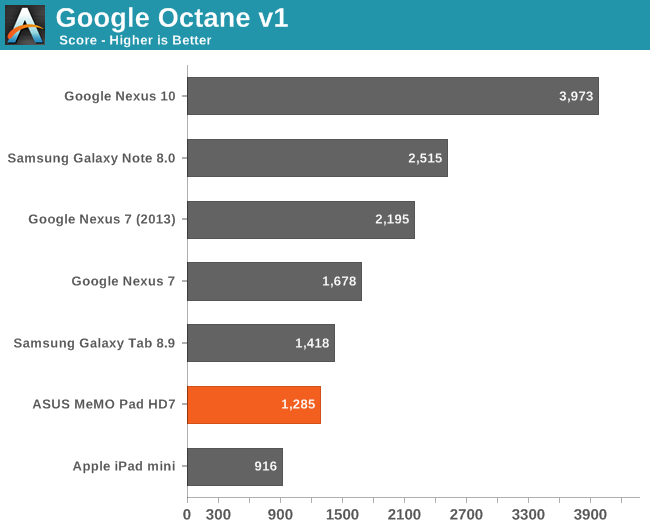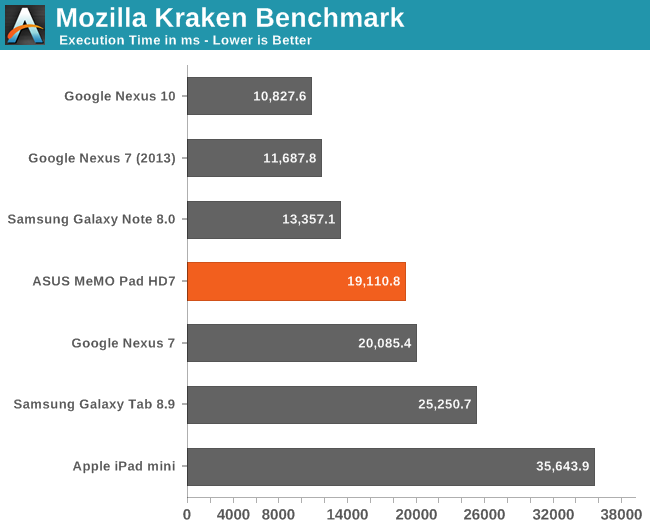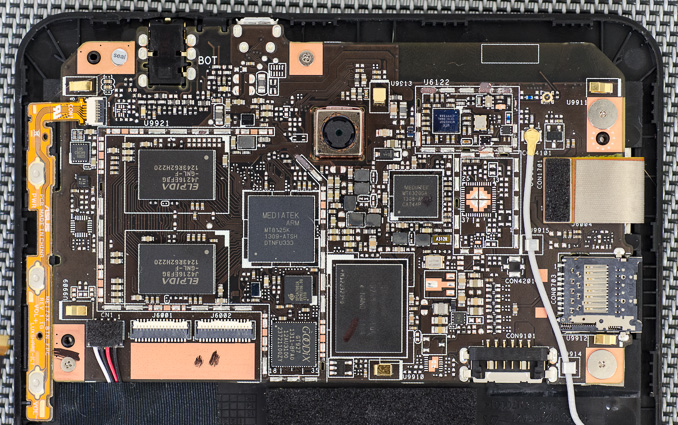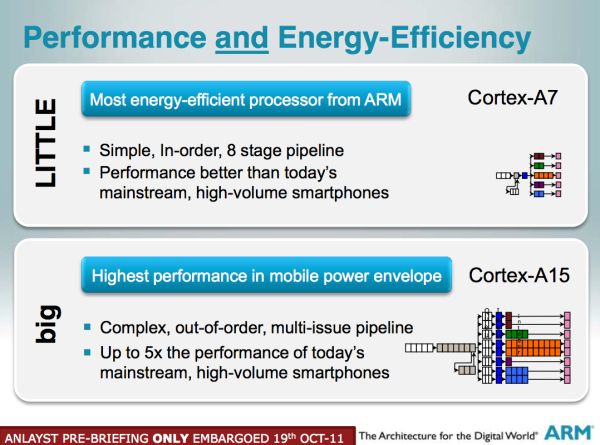ASUS MeMO Pad HD7 Review: $149 Nexus 7.1 Successor & Our First Look at MediaTek's MT8125
by Anand Lal Shimpi on July 29, 2013 3:55 PM EST- Posted in
- Tablets
- Asus
- Mobile
- Android 4.2
- MeMO Pad
MediaTek MT8125 Inside
To hit its $129/$149 price point, ASUS outfitted the MeMO Pad HD7 with a quad-core Cortex A7 based SoC from MediaTek: the MT8125. Before we get to the specifics of this SoC, it's important to put MediaTek in perspective since this is the first time we've ever reviewed one of its SoCs.
In our SoC coverage at AnandTech we tend to focus on the big five: Apple, Intel, NVIDIA, Qualcomm and Samsung. TI dropped out of the AP (Application Processor) space, and ST-E's future as a company is a bit uncertain. The benefit of ARM's business model however is that anyone can put its cores and/or ISA to use. You just need to have enough funding to pay for an ARM license and build an implementation team to get your SoC off the ground. While we're used to low cost markets being addressed by de-featured versions of high-end chips, in the ARM ecosystem there's another solution: the rise of the high-volume, low cost SoC vendor.
MediaTek, a Taiwan based fabless semiconductor manufacturer, is one of a number of ARM licensees that are presently giving Qualcomm (and other mobile SoC vendors) a hard time. They tend to take vanilla ARM (and 3rd party) IP, integrate it, and sell it for much less than the ARM licensees we're used to covering. Just as ARM's licensees are putting incredible pressure on Intel's margins in client computing, MediaTek is doing the same to the bigger ARM licensees.
Last year MediaTek shipped just under 1.7 billion chips. Granted that's across all markets that it serves (including APs, WiFi, GPS, DVD/BD player chipsets, etc…), but it's still tremendous volume.
If you look at any of the sub-$150 Android tablets these days, they all integrate some form of ultra low cost silicon. In large, cost-sensitive markets (e.g. China), MediaTek's presence is extremely high.
The MT8125 integrates four relatively early revision ARM Cortex A7 cores (r0p2). Each core can run at between 500MHz and 1.2GHz, and each core can be hot-plugged independently. I ran a bunch of low level memory tests and it looks like MediaTek opted for a fairly sensible 32KB/32KB L1 cache configuration (I$/D$). The L2 cache appears to be 1MB in size, shared between all four cores. NEON is supported.
Of the four cores, I noticed the first two are frequently active, with clock speeds usually up at 1.2GHz whenever you're doing anything (loading apps, scrolling, etc…). The third core usually plugs in to keep responsiveness up while doing anything more CPU intensive. The fourth core seems to occasionally get plugged during normal, non-heavily threaded use, but even then for very short periods of time.
We've only briefly discussed ARM's Cortex A7 here, so I'll offer some more details on the architecture since it's relevant. The Cortex A7 is ARM's Cortex A5 successor. It's a light-weight 32-bit core that is fully ISA compatible with the Cortex A15 (which is why we see it used in big.LITTLE configurations with the A15). The A7 is a fully in-order micro-architecture, unlike the OoO Cortex A9 (at least with respect to integer instructions). The A7's integer pipe is 8 stages deep, and has limited dual-issue capabilities (e.g. FP/NEON can't be dual-issued, branches can only be issued from one port, etc…). The execution back end is quite similar to the Cortex A8.
ARM's goal with the Cortex A7 was to deliver similar performance to the Cortex A8, but in a smaller area and at lower power. ARM claims a single Cortex A7 core could be fit into a 0.5mm^2 area on a modern 28nm process. That's roughly 1/6 the area required to implement a single AMD Jaguar core.
Feeding the quad-core Cortex A7 cluster is a single-channel (32-bit wide) DDR3L memory interface. ASUS opted for two 16-bit DDR3L-1066 devices on-board. My review sample used Elpida DDR3L, the same type found in iFixit's teardown of the new Nexus 7.
Performance in our standard suite of web based tests has the quad-core Cortex A7 MT8125 trading blows with the quad-core Cortex A9 Tegra 3 in the Nexus 7. When the two are similar, they tend to be pretty close, but when there's a lopsided victory it's usually well in favor of the Tegra 3/Nexus 7. That tends to mirror my experience with the MeMO Pad HD7. In many cases it feels close to the 2012 Nexus 7's performance, but there's an element of snappiness that's just not present. Some Android animations are a little choppier (e.g. bringing up the apps grid) compared to the Nexus 7. I do wonder how good MediaTek's memory controller implementation is. Remember that ARM only has to provide the CPU IP, the rest of the SoC is up to the designer to build/source.















75 Comments
View All Comments
timon_comment - Thursday, August 1, 2013 - link
The "ASUS 7-inch Tablet Specification Comparison" the list was lacked an important function, ---- GPS module.Not all of the tablet are providing GPS module for you, even though in WiFi iPad are also no GPS module. (no need to say what A-GPS --- a fake GPS, it running is incapable of without wireless network)
ASUS's the three models have GPS module, whether it is as a WiFi version or a 3G version.
ASUS tablet's GPS performance got improved ever since the Nexus 7 (2012) launched.
In Android tablets are only for the two brands provided the dependable GPS performance, another is Samsung tablet, like Galaxy Note 8, Galaxy Tab3 T210, Galaxy Tab3 T310, etc..., whether it is as a WiFi version or a 3G version.
user777 - Thursday, August 8, 2013 - link
Not quite correct comment. Assisted GPS or A-GPS is also functioning as autonomous GPS. Indeed an aluminium case (tablet, smartphone) may be a reason for not quite good performance.You may check-up the Asus(.)com web site - all Asus tablets support GPS (+Glonass for some areas) except the very first ASUS MeMO Pad ME 172V (1024x600 display, not HD).
From my personal experience Asus Nexus 7 has the best GPS I know - much better sensitivity than any GPS navigation device. It gets GPS signal in seconds and has excellent sensitivity (inside car, train, in a room near the window even behind sunblind).
BTW I would like to see a review of the latest Asus Memo Pad FullHD 10. It is already on the market with better price than Samsung Nexus 10.
timon_comment - Saturday, August 10, 2013 - link
you are inaccurate,Some devices just support for A-GPS but is no GPS module. that A-GPS is depending on wireless network.
Although it seems like the WiFi iPad could provide some limited navigation (without the GPS module), actually is just a gyro sensor, NOT GPS, incapable to do random position measuring.
What is a gyro electronic navigation? Please note to some of missiles.
"It gets GPS signal in seconds and has excellent sensitivity (inside car, train, in a room near the window even behind sunblind)."
you did not turn off the WiFI signal and remove all the cache, the A-GPS was still working, so, may be faster.
However, mountainous areas are likely no WiFI signal, or you are being a trip overseas occurred during no free-WiFi over there.
Also, in mountainous areas, if you wanted to get a position measuring, must be with GPS.
timon_comment - Tuesday, August 13, 2013 - link
I have to make a correction to my post above,although some sellers claiming MeMo Pad HD 7 has embedded GPS, however ASUS's official webpage of the MeMo Pad HD 7 did not list the GPS sensor nor Gyroscope sensor, so I thought the MeMo Pad HD 7 is likely no GPS sensor (module).
Nexus 7 (2012) and Nexus 7 (2013) have GPS module
timon_comment - Tuesday, August 13, 2013 - link
it seems like I have to make 2nd correction,Maybe ASUS's official webpage is very bad
Seems others who have already tested GPS on the MeMo Pad HD 7, and said GPS in the MeMo Pad HD 7 is slightly worse, it has a MT6628 processor with WiFi/BT/GPS/FM combo chip, a cheap way.
extide - Thursday, August 1, 2013 - link
I wouldn't be so sure that the MTK SoC in there is indeed made on the 28nm process, in-fact I would not be surprised at all if it was on 40nm. There are lots of interesting Cheap CHinese SOC's out there though, it would be cool to see some tested. Like RockChip, Allwinner, Freescale i.MX, etc.eebrah - Friday, August 2, 2013 - link
@extide Freescale is not ChineseWolfpup - Friday, August 2, 2013 - link
I wonder if these are stock Android, and if so if that means they'll be updated promptly like Nexus.Assuming so, then both this, last year's 7, and this year's 7 are really awesome pieces of hardware for the price.
Other than being pocketable I vastly prefer a 10" tablet though, and...ugh...Android just isn't all that useful to me compared to iOS, much less Windows. (Where are the AMD based Windows tablets?!? They've got better CPUs and GPUs and drivers than Atom, and they're just screaming to be put in tablets...)
VisionxOrb - Thursday, August 8, 2013 - link
Sero 7 pro from walmart is killer deal as wellTutua - Thursday, August 15, 2013 - link
Does know anyone if this tablet supports MKV files? if yes, files with a size +4gb? I want to use this tablet like a portable video player during my journey...